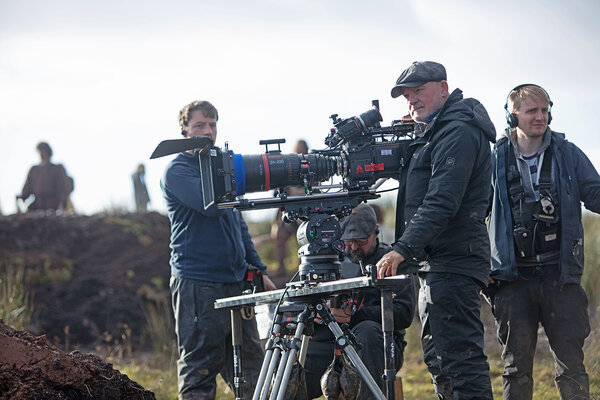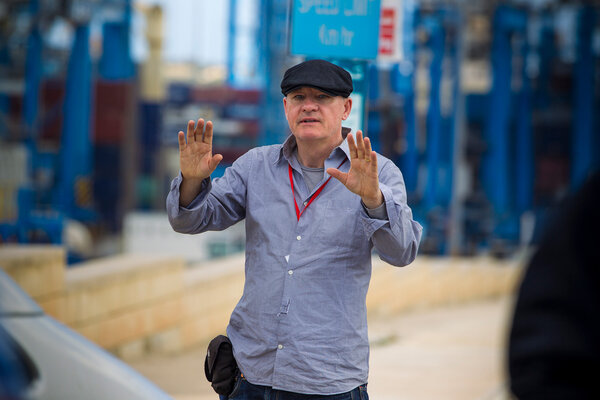Festival de Cannes 2023
Discussion with Barry Ackroyd, BSC, 2023 "Pierre Angénieux Tribute"
"Zoom zoom jazz", by François Reumont, for the AFCHe then altered dircetion and worked with Paul Greengrass (United 93, Captain Philips) and filmmaker Kathryn Bigelow, whose films The Hurt Locker and Detroit he shot. Barry Ackroyd, BSC, reminisces with us about his exceptional career and discusses how he creates cinema. (FR)
What does Cannes mean to you ?
Barry Ackroyd : I’ve been to Cannes a couple of times with Ken Loach ! The main screening room is really impressive. I recall my first screening in competition, I hadn’t dared to sit with the rest of the crew. I’d found a seat all alone in the first rows. At the end of the film, I even missed the group who was headed to the party ! Looking back, I still get nervous thinking about it ! It was a happy surprise to see Ken in competition again this year. Otherwise, Cannes, for me, is also arriving at Nice on Ryan Air, figuring out how to catch the bus to Cannes, putting on a dinner jacket and finding yourself suddenly in the Lumière theater and having an unforgettable time. I particularly remember the year where we presented My Name is Joe. After, there was a party with lots of Scottish people who had come to celebrate us ! The next morning, you haven’t slept, walk the streets of Cannes near the Palais with all the guys cleaning the streets… and then you go back to normal life once you get on the plane ! Each time, it’s a bit of a whirlwind, but honestly, it’s fabulous ! I think especially since Brexit, it’s heartwarming to have experiences like that, because you feel how cinema can cross all borders with its universal language.
You’re a cinematographer who likes his zoom lens… tell us about your passion !
BA : I come from a background in fine arts. Not a cinema school. That has had a significant impact on how I see things. Sculpture , the sense of weight and movement in the work is very important to me. That’s exactly how I go about lighting a set. This relationship to movement comes also from the way I shoot. It’s perhaps somewhat strange to think of a sculptor’s movements, but that’s what I have in mind when I get behind the camera. My passion for the zoom lens comes from my documentary apprenticeship. I recall my first films with an Éclair 16mm and an Angénieux 12-120 lens. Taking the camera up against you, steadying it on your shoulder, and becoming one with it. Your left hand naturally places itself on the zoom ring and you’re off !
I can’t give up that feeling. But today, when I’m working with a heavier, modern digital camera, I simply use a Slider and the 24-290 Angénieux zoom ring naturally falls into my hand just like in the days of the Aaton super 16mm. Perfectly balanced, with my eye in the viewfinder, the zoom ring is just ideal for being used directly by hand. You don’t need a motor, a remote control, or even a rod. It’s a bit like playing jazz. You feel like you’re at the heart of the film’s rhythm. The only thing that I strangely feel is missing is the sound of film running in camera body. The little purring noise that used to go along with shooting. That noise made everyone on set concentrate. It was the marker of a certain intensity. When, as a cameraman, you throw yourself into sho, believe me, you have to listen just as hard as your eye is fixated on the shot !

What do you think about the shift towards ultra-high definition, resulting from the arrival of the streaming platforms ?
BA : I think the race towards greater definition is sterile. How many people actually watch the films in those kinds of conditions ? I continue to believe you can still do excellent work with S16mm. Take the example of Detroit, the latest film I made with Kathryn Bigelow six years ago. No one has ever once said anything to me about the low definition or the image quality. Exactly like The Hurt Locker, the film we’d shot before that, entirely with four Aaton Super 16 cameras. Most people thought it’d been shot on 35mm. If you want to talk about the future, I’m mainly worried about artificial intelligence. When you see what machines are capable of creating by themselves in terms of photography, I’m afraid that in a more-or-less near future, we’ll get films made the same way. The camera positions, lighting and movements, everything can be saved and entered into databases on a set so that the computer can then imitate them, right ? So, can’t we then expect to soon see films that have been entirely created without the use of a single lens ? That, for filmmakers, will be a true end when it happens.
You mentioned The Hurt Locker. Besides the fact the film received the Oscar for Best Film and Best Director, was it a turning point in your career ?
BA : Meeting Kathryn Bigelow was certainly a turning point. For example, she’s the one who encouraged me to work with several cameras. Up to then, with Ken Loach, etc I’d only almost ever worked with one camera at a time, mostly with a fixed lens. Then, I was suddenly faced with having to shoot with two or three cameras at the same time. That profoundly changes the way you approach a film. I don’t know if both parts of my career can be summarized so simply, but I do feel that there is surely a before and an after Hurt Locker.
At the same time, the relationship to realism is always at the center of your work, whether it be in Glasgow or in Hollywood…
BA : The relationship to realism has always been inside me. In Britain, when I was getting started, there was a very strong tradition of documentary filmmaking. People like Chris Menges, for example, who used to make wonderful films. Even before I worked as director of photography myself on a fiction film, I’d already traveled to nearly 50 countries shooting documentary after documentary. I think that left its mark on me and the joy of capturing the world with a camera became second nature. My choice gradually fell on films that might resonate with that feeling. Even though I was suddenly able to shoot a scene with a crane or a traveling car, I always continued to ask myself the question about realism and how I would have portrayed the scene during my documentary days. Later on, when Paul Greengrass contacted me, he said it wasn’t because of my work on Ken Loach’s films. On the contrary, what had impressed him was my work on drama documentary films such as Hillsborough or Sunday.

You often mention the musicality of camera work. Did your way of lighting also change ?
BA : I think that over time, as a cameraman, you give up your desire for perfect lighting and you move closer towards realism. Also, the tools available change and make your job easier. Now, with LEDs Lights, with a lightboard operator and a good gaffer, you can almost light an immense set at Cinecittà entirely with prop lights that can be directly controlled, as I recently did on The Old Guard 2. On the other hand, some other aspects, such as how to render the faces of two actors with different skin-tones can be harder to solve in digital than in the old film days. But those remain accessory issues because those problems can usually be solved during digital postproduction… I think that’s actually the major revolution in our field. Digital color grading has profoundly changed mindsets, especially with the appearance of the magical sentence "we’ll do that in post !".
Let’s go back to the zooms. Why are they so important to you ?
BA : The most important piece of a camera is the lens, in my opinion. That’s its eye. If you lose it, you lose humanity. And that’s why I think the zoom is much more valuable to me on set than a fixed lens. Using the zoom, I can seek out emotion as I listen to the performance. Even if you’re shooting in Cambodia or Romania, and you can’t understand a word of what’s being spoken, the language of humanity is still there, and the zoom lens lets you follow that emotion. Look, I remember moments on The Hurt Locker where Kathryn Bigelow would come see me at the end of a scene and say, “Come on Barry, let’s do one last take, and you can do whatever you want behind the camera… put it on your shoulder and show me what you see !” In moments like those, the zoom lens becomes your eye. You can suddenly go and single out one person in a crowd, you can do a whip pan, you can suddenly give a highly sculptural third dimension to the image. That’s exactly what the zoom on a camera means to me.
Yet, certain filmmakers hate the zoom lens. They feel it makes the camera more distant from the actors.
BA : It’s the opposite. With a fixed lens, I feel like scenes are cut shot by shot in a very choppy way. But with a zoom, you can shoot the entire scene in one take, or at the very least you can do it using several values without the actor ever noticing. I recall, for example, the first days of shooting on Captain Phillips with Tom Hanks. He turned around at the end of a take to look at Paul Greengrass, the director, and asked him what extra cut aways he needed for the scene… Greengrass replied with a smile “Tom, it’s OK, Barry already done it !” Of course, it isn’t about zooming in and out, like a toy. No, it’s about finding the right balance and the right scale for each shot at every moment, and the right rhythm. Whether the actor decides to stand up or not… whether he goes to the back of the room or remains close to the camera… It’s impossible to do the same thing if you’re shooting with a fixed wide-angle lens. You know, using the zoom is an art. It’s like a musical instrument. Jazz, absolutely like jazz.
Is there one scene in your entire filmography that you have in mind as something you’re particularly proud of ?
BA : Green Zone by Paul Greengrass. There’s a chase sequence in the streets of Baghdad at night with Matt Damon. There were lots of pages of the script to cover and suddenly we got the news : our star had to leave earlier than planned. I recall that the crew and I spent an hour and a half to organize everything so that we would be able to shoot the entire sequence in just one take. By setting three cameras up along the path, the first I had on my shoulder, the second was on a Cable Cam that took over, and the third was on a Steadicam waiting for him at the end of the cable. Then, I took over for the end of the scene with the camera on my shoulder in a car, while I’d run off-screen in parallel to the action. We weren’t trying to shoot a long take, but just to cover enough useful minutes in such a little amount of time. It was truly a challenge and when Matt left running for the airport after three takes, we were all so proud that we’d been able to make the scene.
(Interview conducted by François Reumont, and translated from French by Alexander B. Raiffe for the AFC)
 En
En Fr
Fr





